Convenience and Compliance when Treating Otitis Externa (Advertorial)
01 Mar 2024
The successful treatment of canine otitis externa has traditionally relied on good owner compliance, requiring multi-dose administration of medication at home.
A market survey revealed however that over half of European dog owners thought administering an ear medication twice daily for up to 14 days at home would be difficult or even impossible.1. Even when the proposed treatment frequency was reduced to two doses in 7 days, 40% still felt this would be difficult or impossible to do.1
Otitis externa represents up to 20% of the entire canine veterinary caseload.2 These survey findings therefore suggest that potentially more than 1 in 10 of all the dog-owning clients that a small animal vet sees, could view the treatment protocol advised to them as challenging, if not completely unachievable.
The practicalities and emotion of compliance
Even when owners fully intend to follow vet advice, practical and emotional factors can lead to non-compliance over the course of treatment. The longer the course of home treatment required, the more difficulties owner seem to face in staying compliant.1
For example, the volume of medication that is administered per dose is important for clinical efficacy.3 A study has shown that up to 80% of owners give the incorrect dose when administering ear products to their dog.4
Administering ear medication at home and accurate dosing is made even harder when dogs are made ‘ear shy’ or become stressed during treatments. The obvious distress of their pet can cause feelings of guilt for owners. For some, this may be enough to cease treatment.
86% of owners indicated that reducing stress for their dog was a priority when treating ear infections.1
What’s their preference?
Considering owner preferences can be powerful in improving compliance.3 72% of dog owners would prefer a single dose treatment administered by the vet if their dog was diagnosed with otitis externa.1 This includes those that were not concerned about administrating ear treatment at home, demonstrating that just because owners think they can, it does not mean they want to.
Reserving the use of NeptraTM for difficult to manage or aggressive dogs is not recommended, as the true benefit of the single-dose treatment is not only in its efficacy but also in its prevention of the dog developing head shyness or ear-phobias due to negative associations with repeated ear treatments.
“Once we get an animal that becomes ear-phobic, it makes it really difficult for us as vet surgeons to examine them, and it makes it even more challenging for the owners to actually apply medication into those dog’s ears, thereby reducing compliance.” Dr Sue Paterson, M.A. VetMB. DVD DipECVD FRCVS. President of the World Association for Veterinary Dermatology
NeptraTM -treating otitis externa just got easier
Neptra is an effective option for the treatment of acute otitis externa in dogs and the first otic solution to be administered in one single dose, by the vet. Provided as an easy 1 ml pre-measured dose, suitable for all breeds and sizes, Neptra offers complete control over compliance in the treatment of otitis externa.
References: 1. Elanco. Data on file. 2. Angus J C: Otic cytology in health and disease. Vet Clinics of North America. Small Animal; 2004, 34, 411-424 3. Tim Nuttall. Successful management of otitis externa. In Practice, May 2016. Volume 38, Issue Suppl 4. Boda F, et al. Evaluation of owner compliance with topical treatment of acute otitis externa in dogs: A comparative study of two auricular formulations. Intern J Appl Res Vet Med, Vol 9, No 2, 2011 5. Blake JD, Keil DDP, Kwochka KD, Palma KP, Schofield JD. Evaluation of a single-administration ototopical treatment for canine otitis externa: a randomised trial. Veterinary Record Open. 2017: 4:e000219 6. Sue Paterson, 2018. The use of antibiotics and antimycotics in otitis. UK Vet Companion Animal, (23), 11, 608-613
Neptra is not recommended in cases with rod-shaped bacteria present on cytology sample, as these may represent Pseudomonas aeruginosa. C & S testing should be performed when appropriate to determine the identity and susceptibility of the causative organism(s). Use in cats should be avoided. Read and follow label instructions.
